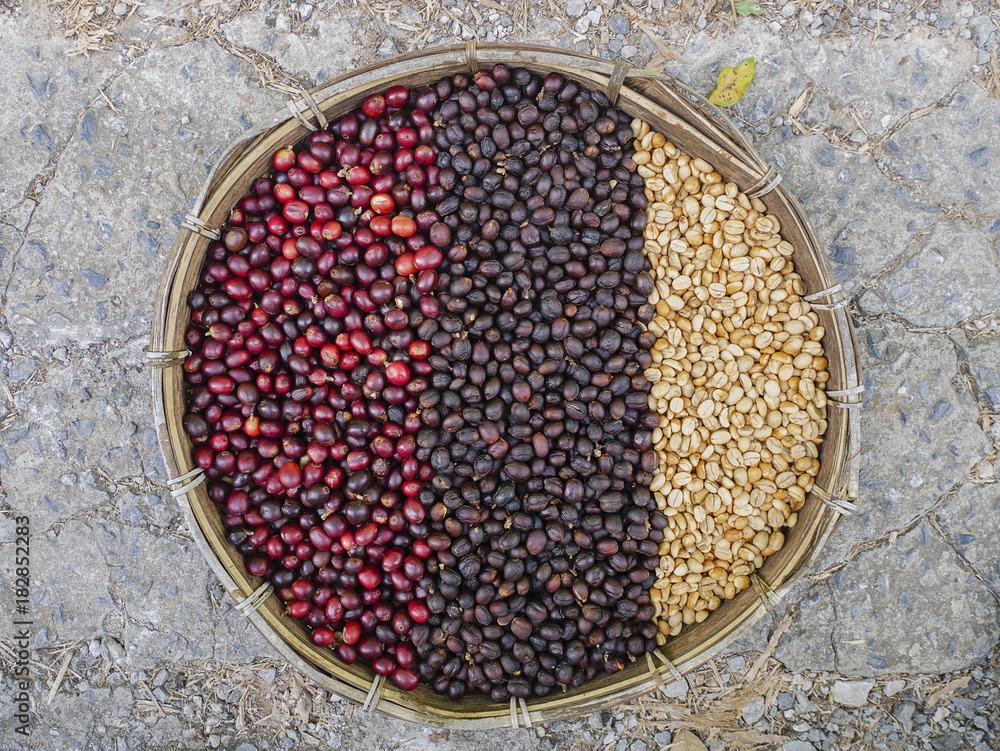Coffee is an integral part of Saudi culture, representing a symbol of hospitality and social interaction. However, what makes a cup of coffee special isn't just the type of bean or the brewing method, but also the processing of the beans after harvest. The processing process greatly influences the final flavor of coffee, whether it's fruity, floral, or rich with chocolate. In this article, we'll explore the impact of processing on coffee flavor, the main processing types, and how coffee lovers in Saudi Arabia can choose the right type to suit their taste. At Rafah Al-Qahwa, you'll find everything you need from specialty beans and brewing tools to create the perfect coffee experience that reflects the effects of processing.
What is coffee processing?
Coffee processing is the process performed on coffee cherries after harvest to separate the green beans from the outer skin and mucus. This process affects the flavor, acidity, body, and final aroma of the coffee. Processing is a crucial step in the coffee production chain, determining the characteristics that will appear in the cup. There are three main processing methods: wet (washed), dry (natural), and honey, in addition to other innovative methods. Each method produces different flavors to suit the tastes of different coffee lovers.
Why does processing affect the flavor of coffee?
Coffee beans are made up of chemical compounds such as sugars, acids, and essential oils, which interact during processing. The processing method determines how these compounds interact with the environment (water, sun, or fermentation), affecting:
- Acidity: Wet-processed coffee is often more acidic and cleaner.
- Body: Dry processing produces coffee with a heavier body and more intense flavors.
- Flavors: Honey processing adds sweet, fruity flavors due to the mucus remaining on the grains.
- Aroma: Different methods bring out floral, fruity, or earthy aromas depending on the length of fermentation or drying.
Types of coffee processing and their effect on flavor
1. Wet Process (Washed Process)
- Description: The outer shell of the coffee cherry is removed using dehulling machines, and the beans are then soaked in water tanks to ferment the surrounding mucus (usually 12–36 hours). The beans are then dried in the sun or in dryers.
- Flavor effect:
- Clean, bright, citrusy flavors (such as lemon, apple, or jasmine).
- Light and transparent texture.
- It highlights the original flavours of the beans, making it ideal for specialty coffee.
- Examples:
- Ethiopian Yirgashi Coffee (floral and citrusy notes).
- Washed Colombian coffee (caramel and citrus flavors).
- Preferred uses:
- Ideal for brewing with a Hario V60 or Chemex from the Coffee Wellbeing Store.
- Why do you prefer it?: It's suitable for coffee lovers in Saudi Arabia who are looking for pure, acidic flavors, especially with specialty coffee.
2. Dry Process (Natural)
- Description: The entire coffee cherries, including the husk and mucus, are sun-dried for 2–4 weeks, after which the husk is mechanically removed. This method is used in low-humidity areas such as Ethiopia and Yemen.
- Flavor effect:
- Rich, fruity flavors (such as berries, mango, or dried fruits).
- Heavy and dense texture.
- Sweet, complex aromas, sometimes earthy or wine-like.
- Examples:
- Yemeni Mocha Coffee (chocolate and dried fruit flavors).
- Ethiopian Harrar Coffee (berry and wine flavors).
- Preferred uses:
- Ideal for espresso or cold brew, bringing out rich flavors.
- Why do you prefer it?: It's perfect for coffee lovers in Saudi Arabia who prefer strong, sweet flavors, especially with traditional Arabic coffee.
3. Honey/Pulped Natural Process
- Description: Only the outer husk is removed, leaving the mucus layer on the beans during drying. This method produces flavors that are somewhere between wet and dry, and is called "honey" due to the sticky texture of the mucus.
- Flavor effect:
- Sweet, fruity flavors (such as honey, peach, or caramel).
- Medium to heavy consistency.
- Balance between acidity and sweetness.
- Examples:
- Costa Rican Honey Coffee (Honey and Apricot Flavors).
- Honey Brazilian Coffee (chocolate and nut flavors).
- Preferred uses:
- Great for brewing drip or espresso using tools like Chemex.
- Why do you prefer it?: It is suitable for those looking for a balanced experience that combines sweetness and acidity.
4. Innovative treatment (such as anaerobic fermentation)
- Description: The beans are fermented in airtight tanks without oxygen, producing unique and unconventional flavors. This method is used on specialty coffee farms.
- Flavor effect:
- Complex and exotic flavors (such as rum, tropical fruit, or spices).
- High acidity and rich texture.
- Examples:
- Colombian anaerobic coffee (pineapple and spice flavors).
- Preferred uses:
- Ideal for preparing specialty coffee using drip coffee machines.
- Why do you prefer it?: It suits those who love new experiences and bold flavors.
Factors affecting treatment success
- Cherry Quality: Only ripe cherries should be harvested for optimal flavors.
- Climate: Humidity and temperature affect drying speed and mold prevention.
- Fermentation: The duration and method of fermentation in wet processing determines the acidity level.
- Drying: Uniform drying prevents the development of unwanted flavors.
- Experience: The farmer's skill in controlling each stage affects the final result.
Effect of processing on preparation methods
- Espresso: Dry or honey-processed coffee produces a rich espresso with a thick body and sweet flavors.
- Drip (V60, Chemex): Wet-processed coffee is ideal for dripping because of its clean flavors and bright acidity.
- Cold Brew: Dry or honey-processed coffee brings out fruity and sweet flavors in iced coffee.
- Arabic coffee: Dry-processed coffee is suitable for preparing traditional Arabic coffee due to its rich flavors.
Why is processing important to coffee lovers in Saudi Arabia?
- Culture and Tradition: Traditional Arabic coffee is often prepared from dry-processed beans, reflecting Saudis' attachment to rich, robust flavors.
- The growing popularity of specialty coffee: With specialty coffee shops popping up in Riyadh, Jeddah, and Dammam, coffee lovers are looking for diverse flavor experiences, such as the acidity of wet-processed or the sweetness of honey-based coffee.
- Hot weather: Iced coffee (cold brew) is popular in Saudi Arabia, and the dry processing adds fruity flavors that suit this type of drink.
- Sensory Experience: Saudis prefer coffee as part of their daily ritual, and the processing allows for a variety of flavors that enhance this experience.
Tips for choosing coffee based on processing
- For lovers of clean, acidic flavors: Choose a wet-processed coffee (like Ethiopia Yirgashi) and brew it with a Hario V60 from the Coffee Luxury Store.
- For lovers of rich, sweet flavors: Try dry-processed coffee (such as Yemen Mocha) to prepare espresso or Arabic coffee.
- For balance lovers: Choose a honey-processed coffee (such as Costa Rican) to balance sweetness and acidity.
- For bold experiments: Look for anaerobic-processed coffee for unconventional flavors and brew it by drip.
- Use proper tools: Tools like a Chemex, Hario Cold Brew, or Baratza Encore grinder from the Coffee Wellness Store highlight the processing effect.
- Read the bean label: Check the processing method on the coffee package to choose the flavor that suits your taste.
- Try Cold Brew: Use dry or honey-processed beans with your Cold Brew Maker to make refreshing iced coffee.
- Order from trusted sources: Otavo beans from the Luxury Coffee Shop come from farms that offer a variety of treatments to suit all tastes.
Challenges associated with processing
- Cost: Wet processing requires clean equipment and water, which increases the cost of coffee.
- Time: Dry processing takes longer, which may affect production speed.
- Environmental impact: Wet processing consumes large amounts of water, while dry processing requires a suitable climate.
- Quality: Any error in fermentation or drying may result in undesirable flavors such as mold.
Solution: Choose beans from trusted farms like those offered by Luxury Coffee, where processing quality is strictly controlled.
Coffee processing is the key factor that determines the flavor of your cup, whether you prefer clean, acidic notes, sweet, fruity flavors, or exotic, complex flavors. From wet processing, which highlights acidity, to dry processing, which adds a heavy body, each method offers a unique experience that suits the tastes of coffee lovers in Saudi Arabia. At Rafah Coffee, you can choose from specialty Otavo beans and professional brewing tools to experience each flavor to its fullest. Whether you're making traditional Arabic coffee or a refreshing cold brew, understanding processing will forever change your coffee experience. Order now from Rafah Coffee and enjoy a cup that tells the story of the processing.

